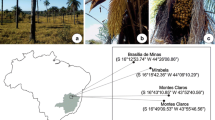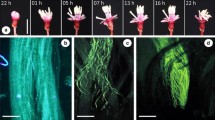Abstract
The floral biology ofTricyrtis latifolia was investigated at four sites: Nigorigo, Kurumijima and Hikagedaira-san, Gifu Prefecture, and Jöge, Miyagi Prefecture. The flowers open fully by 3 a.m., and anthesis begins at about 8 a.m. Most pollen is taken away by bumblebees by 10 a.m. The distal parts of the trifid style-branches (each branch is further bifid) and the immature stigmata are above the anthers in the first day flowers. The distal parts of the style-branches with their extension curve downward and are positioned under the anthers on the morning of the second day and the stigmata are fully matured. The flowers wilt by the third day. The primary pollinators ofT. latifolia wereBombus diversus andB. honshuensis in three sites; only the former was a primary pollinator at the Jōge site. Bees forage the first and second day flowers, and their backs contact the anthers and stigmata of the second day flowers while the bees are sucking nectar. Breeding experiments showed thatT. latifolia was fairly self-compatible. The avoidance of autogamy and the possibility of geitonogamy are discussed.
Similar content being viewed by others
References
Faegri, K. and L. van der Pijl. The Principles of Pollination Ecology, 2 ed. Pergamon Press, Oxford.
Heinrich, B. 1979. Resource heterogeneity and patterns of movement in foraging bumblebees. Oecologia40: 235–245.
Huber, H. 1969. Die Samenmerkmale und Verwandtschaftsverhältnisse der Liliifloren. Mitt. Bot. München8: 219–538.
Hutchinson, J. 1934. The Families of Flowering Plants II. Monocotyledons. Macmillan and Co., London.
Leppik, E.E. 1956. The form and function of numeral patterns in flowers. Amer. J. Bot.43: 445–455.
—. 1957. Evolutionary relationship between entomophilous plants and anthophilous insects. Evolution_11: 466–481.
—. 1968. Morphogenic classification of flower types. Phytomorphology18: 451–466.
Levin, D.A. andH.W. Kerster. 1969. Density-dependent gene dispersal inLiatris. Amer. Nat.103: 61–74.
——. 1974. Gene flow in seed plants. Evol. Bio.7: 139–220.
Macior, L.W. 1974. Behavioral aspects of coadaptations between flowers and insect pollinators. Ann. Missouri Bot. Gard.61: 760–769.
Melchior, H. 1964. Reihe Liliiflorae.In: Engler's Syll. Pflanzenfam.II: 513–543. Gebrüder Borntraeger, Berlin.
Pijl, L. van der. 1961. Ecological aspects of flower evolution. II. Zoophilous flower classes. Evolution15: 44–59.
Proctor, M. andP. Yeo. 1973. The Pollination of Flowers. William Collins Sons and Co., London.
Pyke, G.H. 1978. Optimal foraging in bumblebees and coevolution with their plants. Oecologia36: 281–293.
Takahashi, H. 1980. A taxonomic study on the genusTricyrtis. Sci. Rep. Fac. Educ., Gifu Uuiv. (Nat. Sci.)6: 583–635.
Waddington, K.D. 1981. Factors influencing pollen flow in bumblebee-pollinatedDelphinium virescens. Oikos37: 153–159.
Yamauchi, K., Y. Morimoto, K. Watanabe, S. Sakagami andT. Matsumura. 1982. Bee fauna.In. The Environment Preservation Section of Gifu Pref. ed., The Insects in Gifu Prefecture p. 415–430. Gifu Pref., Gifu (in Japanese).
Author information
Authors and Affiliations
Rights and permissions
About this article
Cite this article
Takahashi, H. The floral biology ofTricyrtis latifolia Maxim. (Liliaceae). Bot Mag Tokyo 97, 207–217 (1984). https://doi.org/10.1007/BF02488694
Received:
Issue Date:
DOI: https://doi.org/10.1007/BF02488694




